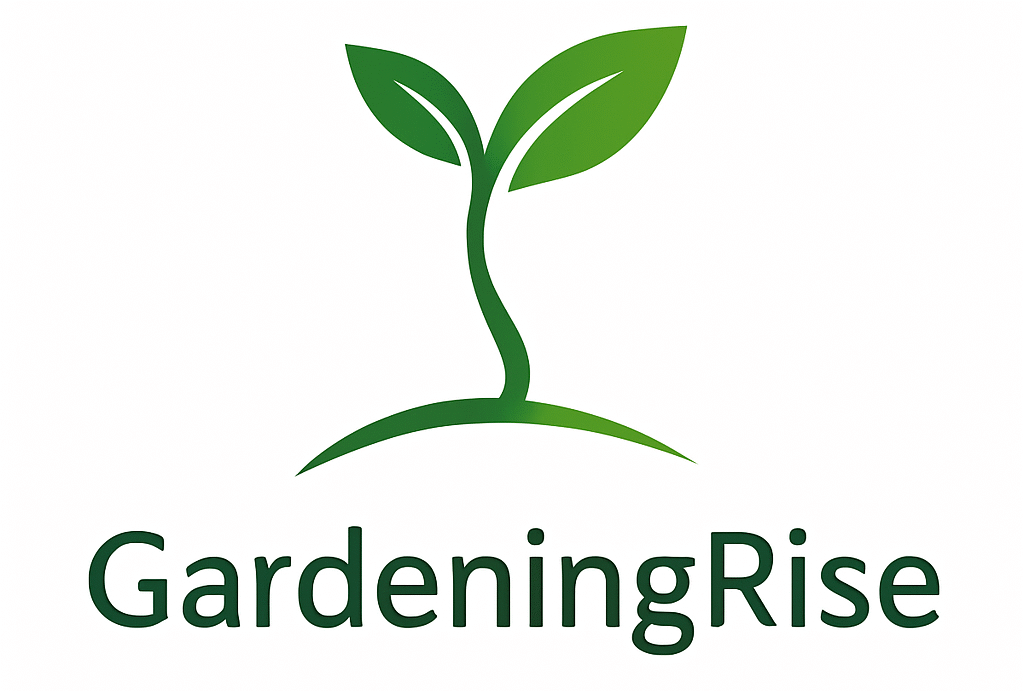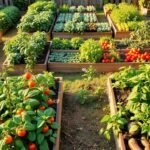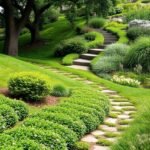When building your outdoor planting space, the foundation you choose shapes everything from plant health to landscape beauty. Your selection influences how well your setup withstands weather, pests, and time while keeping soil safe and productive. Durability matters—whether you’re dealing with harsh winters, curious wildlife, or simply years of use.
You’ll want options that balance practicality with visual appeal. Some choices might cost more upfront but save money long-term by avoiding frequent replacements. Others prioritize eco-friendly designs using recycled components. Each material brings unique strengths, from heat retention to chemical-free safety.
This guide helps you navigate key factors like climate suitability, maintenance needs, and personal style. You’ll learn how different constructions affect root development, weed control, and even how your backyard looks. Whether you’re growing veggies or flowers, the right foundation ensures your efforts thrive season after season.
By understanding these essentials, you’ll create a resilient, attractive growing area tailored to your goals. Let’s explore what makes certain options stand out—and how to pick the perfect match for your green thumb adventures.
Understanding Raised Garden Beds and Material Options

Elevated gardening redefines how you grow plants, blending practicality with creative design. These structures let you tailor soil conditions while reducing physical strain, making them ideal for both beginners and seasoned gardeners. Whether you’re growing herbs or tomatoes, the right setup enhances productivity and aesthetics.
Benefits of Elevated Gardening
Better drainage prevents waterlogged roots, giving plants the air they need to thrive. You’ll also notice fewer weeds competing for nutrients. The height means less bending, which is a game-changer if you have back issues or limited mobility.
Elevation acts as a natural barrier against slugs and burrowing pests. Soil in raised beds warms faster in spring, letting you start seeds earlier. In fall, it stays productive longer—perfect for extending your harvest of leafy greens or root vegetables.
Overview of Popular Materials
Recycled plastic stands out for its durability and modern look, resisting rot and fading. Galvanized steel adds sleek lines to contemporary yards, while concrete blocks offer a budget-friendly DIY path. Natural wood remains a classic choice but requires more upkeep.
Fabric grow bags are portable and promote healthy roots through air pruning. For a fire-resistant option, cinder blocks work well. Each material impacts your garden’s lifespan and style—choose one that aligns with your climate and how to build a raised bed vision.
Key Factors Influencing Garden Bed Durability
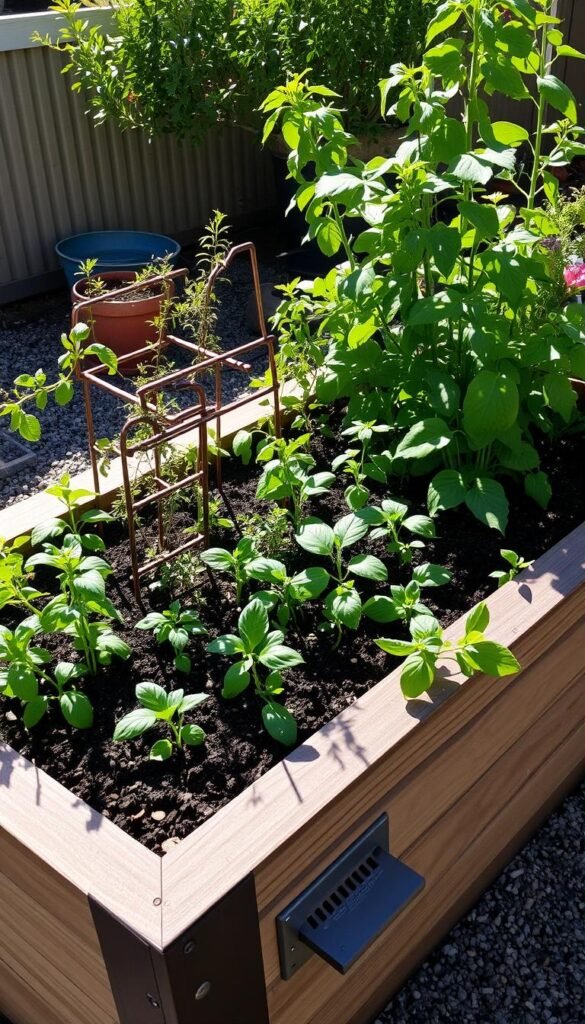
Your outdoor growing space’s resilience depends on how well it handles nature’s challenges. Let’s explore what shapes performance over seasons and how to match your setup to local demands.
Weather and Environmental Considerations
Local climate patterns dictate which options work best. Areas with heavy rainfall test moisture resistance, while intense sun demands UV protection. Coastal regions face salt air corrosion, unlike mountain zones battling freeze-thaw cycles.
Soil acidity plays a hidden role too. Peat-rich mixes accelerate rust in untreated metals, while alkaline soils might preserve them. Consider annual temperature swings—materials expand and contract differently, affecting joints and stability.
Maintenance and Longevity Essentials
Some choices demand yearly treatments, while others age gracefully untouched. Untreated cedar needs sealing, but powder-coated steel resists fading. how to choose the best material involves balancing upkeep time with your schedule.
Wind exposure matters more than you’d think—loose soil erodes faster in breezy spots. Storm-prone areas need anchored designs. By mapping these elements to your yard’s reality, you’ll create beds that thrive through seasons.
Evaluating Metal Options for Raised Garden Beds
Selecting the right metal for your garden setup combines practical durability with design flexibility. Two standout choices—galvanized and corten steel—offer distinct benefits that cater to different needs and styles. Let’s break down what makes these options worth considering.
Types of Metal: Galvanized and Corten Steel
Galvanized steel beds protect your plants with a zinc coating that fights rust. This makes them perfect for rainy climates or areas with heavy dew. You’ll get 20+ years of use without constant upkeep—just wipe off dirt occasionally.
Corten steel develops a weathered look over time. Its rust-like patina acts as armor against corrosion. While the orange-brown hue adds rustic charm, place these beds away from walkways. The runoff can stain concrete but won’t harm your soil.
Safety and Aesthetic Aspects
Always choose coated steel to prevent chemicals from leaching into your veggies. Reputable brands roll edges for safety and use non-toxic finishes. “The right finish matters more than the metal itself,” notes a landscape designer from Portland.
These sleek structures save space with thin walls, giving you extra room for carrots or tomatoes. Their modern profiles pair well with urban gardens, while corten’s earthy tones blend into cottage-style yards. Assembly takes minutes—most kits snap together without drills or saws.
Exploring Plastic Alternatives for Raised Garden Beds
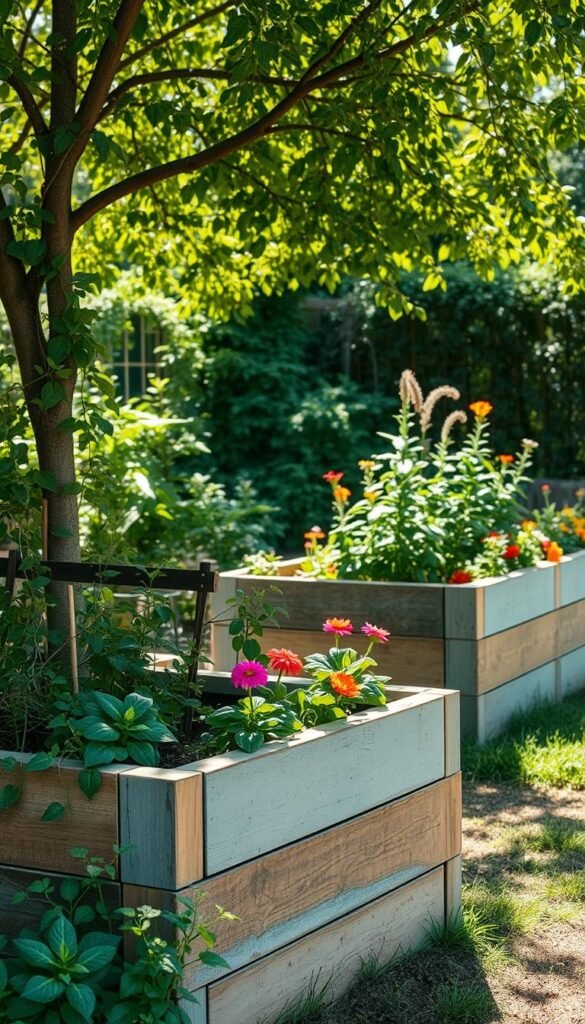
Modern gardening solutions now offer eco-friendly alternatives that blend function with style. Recycled plastic structures stand out as a smart pick for those wanting durability without compromising environmental values. Let’s dig into why these options deserve a spot in your backyard.
Why Reclaimed Materials Shine
Recycled plastic beds turn discarded items into sturdy growing spaces. They’re crafted from milk jugs, packaging, and other post-consumer waste—keeping tons of material out of landfills annually. “This circular approach gives plastic new purpose while protecting ecosystems,” explains a sustainability expert from Colorado.
You’ll love how these setups handle rough weather. Unlike wood that rots or metal that rusts, plastic resists cracking in freezing temps and won’t warp under summer heat. Bugs and moisture can’t penetrate their smooth surfaces, making them ideal for damp climates or termite-prone areas.
Assembly couldn’t be simpler. Most kits click together like puzzle pieces—no tools or DIY skills required. Choose from sleek black, earthy brown, or muted gray to match your patio furniture or house trim. While some prefer the rustic look of wood, these options offer a polished finish that ages gracefully.
Your plants benefit too. The material’s slight flexibility prevents soil compaction, and its insulation properties keep roots cozy. For those considering plastic containers, these beds provide similar advantages but with enhanced stability and design cohesion.
Though pricier upfront than basic lumber, plastic beds save money long-term. No need for stains, sealants, or replacements—just rinse them off each spring. They’re a practical investment for gardeners seeking low-fuss solutions that look great decade after decade.
Design and Functionality in Raised Garden Beds
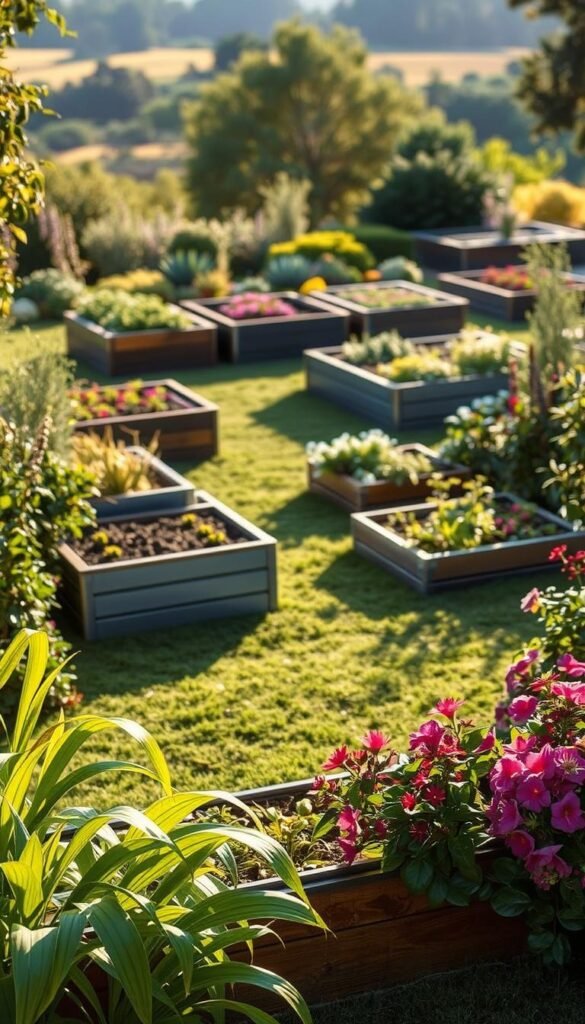
Your outdoor space becomes a seamless extension of your home when materials mirror its architectural character. Style cohesion turns practical growing areas into intentional design statements that elevate your entire property. Let’s explore how to match your setup with your home’s unique personality.
Blending Form and Purpose
Start by identifying your home’s dominant style. Is it a crisp modern box with angular lines? A cozy farmhouse with rustic charm? This decision guides every choice, from colors to textures. “Gardens should whisper the same visual language as your house,” advises landscape architect Mara Klein.
Contemporary homes shine with galvanized steel beds featuring razor-thin edges. Their metallic sheen reflects sunlight, creating depth in minimalist yards. For cottages or colonial designs, cedar or redwood beds add warmth through natural grain patterns.
| Home Style | Ideal Material | Key Benefit | Maintenance Tip |
|---|---|---|---|
| Modern | Powder-coated steel | Clean lines enhance geometry | Wipe with damp cloth annually |
| Farmhouse | Reclaimed wood | Adds rustic authenticity | Apply natural oil sealant every 2 years |
| Mediterranean | Textured concrete | Mimics stucco walls | Pressure wash to prevent moss |
Consider how your raised bed will age. Weathered corten steel develops a striking patina that complements industrial lofts. Recycled plastic maintains its color for decades, perfect for low-maintenance suburban landscapes.
Scale matters too. A sprawling ranch home needs substantial beds to balance open spaces, while urban townhouses benefit from vertical stackable designs. Always leave walking room between structures—aim for 18-24 inches around each planting zone.
Metal vs. Plastic: Comparing Materials for Raised Garden Bed Durability
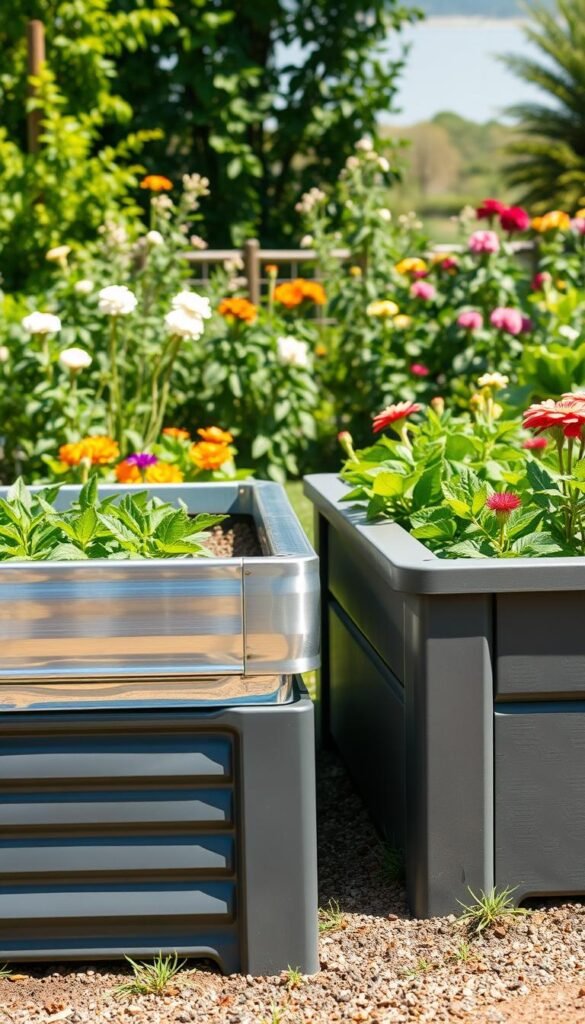
Choosing between two popular options requires balancing immediate needs with future benefits. Let’s break down how these contenders perform in real-world gardening scenarios.
Weighing the Pros and Cons
Galvanized steel structures shine in stability and lifespan. Brands like VioScapes offer 20-year warranties, with prices starting at $120 for 4’x2′ units. Their rigid frames handle heavy soil loads without warping—ideal for deep-rooted plants like tomatoes.
Recycled plastic alternatives counter with unmatched weather resistance. “Our beds withstand -30°F winters and 110°F summers without cracking,” shares a VioScapes product manager. Though pricier upfront, their 50-year warranties and 40% lighter weight appeal to those needing movable setups.
| Feature | Metal Beds | Plastic Beds | Key Considerations |
|---|---|---|---|
| Lifespan | 20+ years | 30-50 years | Plastic outlasts metal in wet climates |
| Maintenance | Occasional wipe-down | None required | Plastic saves 5+ hours/year |
| Cost | $120-$300 | $200-$450 | Metal cheaper initially |
| Eco-Impact | Recyclable | Made from waste | Plastic diverts landfill material |
Making an Informed Decision for Your Garden
Consider how often you’ll rearrange your space. Plastic’s modular design lets you resize beds as crops change. Metal stays put once installed—perfect for permanent installations.
Your local climate tips the scales. Coastal gardeners benefit from plastic’s salt resistance, while arid regions can maximize metal’s heat reflection. Budget-conscious growers might start with steel, then upgrade later.
Ultimately, match your choice to how you garden. Frequent crop rotators gain from plastic’s flexibility. Traditionalists valuing timeless aesthetics often lean toward steel’s industrial charm. Both options deliver lasting results when paired with proper soil care.
Incorporating Your Home’s Architectural Style
Your outdoor space tells a story—one where garden design harmonizes with your house’s personality. Start by observing key features like rooflines, window shapes, and exterior materials. These clues reveal whether your home leans modern, farmhouse, or another distinctive style.
Harmonizing Structure and Nature
Clean-lined contemporary homes pair beautifully with sleek steel beds, while rustic cottages shine alongside reclaimed wood. For Mediterranean villas, textured concrete planters echo stucco walls. Match proportions too—a sprawling ranch needs substantial beds, while townhouses thrive with vertical stackables.
Research your home’s era through local historical records or contractor notes. Mid-century ranches often feature flat planes that align with geometric beds. Tudor Revivals demand organic curves mimicking timber framing. “It’s about creating dialogue between built and grown elements,” notes landscape designer Clara Ruiz.
Your raised garden becomes part of your home’s visual identity when materials mirror its architectural character. This thoughtful approach elevates curb appeal and creates outdoor spaces that feel intentionally curated. The result? A cohesive sanctuary where nature and design grow together.
